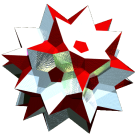thirtyfold dissected icosahedral polytwister,
thirtyfold dissected ikter
- more general:
- n-ike-swirl
- general polytopal classes:
- isogonal noble
links

| Acronym | ... |
| Name |
icosaswirlic hexacosachoron, thirtyfold dissected icosahedral polytwister, thirtyfold dissected ikter |
| Circumradius | ... |
| Face vector | 360, 2160, 2400, 600 |
| Confer |
|
|
External links |

|
The Hopf fibration of the icosahedron maps its vertices to according great circles, its edges into twisted (i.e. non-flat but smoothly curved) faces (then looking like a Möbius strip), and the faces get mapped into twisters, which are solid rings bounded by those twisted faces and having thereby throughout the polygonal cross-section of the pre-image, i.e. are triangular here. Further each twister then gets dissected into n identical chiral antiprisms. This isochoric construction moreover happens to come out to be isogonal as well, so in total provides a noble polychoron.
This polychoron will have 2 types of edges, one describes the right-up lacing edges of the antiprisms (y), while all its remaining edges belong to the other type (x), simply because the neighbouring twister attaches its cross-secting base polygons next to the left-up lacings of the former. That is, the whole polychoron happens to be chiral in general.
In fact, right this connectedness of the mutually swirling individual twisters does further restrict that n after all. This thus brings back into play the former vertex figure of the starting polyhedron – in addition to the so far only considered faces thereof (the cross-sections of the twisters, i.e. the bases of the antiprisms). Because there also is a full inversion symmetry of the outcome of that fibration, we thus finally have to consideder n = LCM(p, q, 2) for a starting polyhedron {p, q}, i.e. n = LCM(3, 5, 2) = 30 in here.
For that specific value it results in this swirlchoron. Here the edge length ratio can be evaluated as y : x = sqrt[(15-3 sqrt(5)-sqrt[30+6 sqrt(5)])/12] = 0.376683.
360 | 2 10 | 15 5 | 10 ----+----------+----------+---- 2 | 360 * | 5 0 | 5 y 2 | * 1800 | 2 1 | 3 x ----+----------+----------+---- 3 | 1 2 | 1800 * | 2 3 | 0 3 | * 600 | 2 ----+----------+----------+---- 6 | 3 9 | 6 2 | 600 chiral trap variant
© 2004-2025 | top of page |